Interaction Preference Differences between Elderly and Younger Exergame Users
Abstract
:1. Introduction
2. Related Work
2.1. Research on the Design of Game for Elderly People
2.2. Exergame
2.3. Classification of Actions
3. Materials and Methods
3.1. Participants
3.2. Game Tasks
3.3. Experimental Equipment
3.4. Experimental Procedure
3.5. Data Analysis and Processing
4. Results and Analysis
4.1. Classification Dimension of Actions
4.2. Preference Differences in Action
4.3. Difference of Action Distribution
4.4. Summary
5. Discussion
5.1. Classification Method of Whole-Body Interactive Actions Suitable for Exergames
5.2. Psychological Model
5.2.1. Reverse Thinking
5.2.2. Simplifying
5.2.3. Connecting with Reality
5.3. Suggestions on the Design of Exergames for Elderly Users
5.4. Limitations
6. Conclusions and Future Work
Author Contributions
Funding
Institutional Review Board Statement
Informed Consent Statement
Data Availability Statement
Acknowledgments
Conflicts of Interest
References
- Norman, D.A.; Nielsen, J. Gestural interfaces: A step backward in usability. Interactions 2010, 17, 46–49. [Google Scholar] [CrossRef]
- Pereira, A.; Wachs, J.P.; Park, K.; Rempel, D. A user-developed 3-d hand gesture set for human-computer interaction. Hum. Factors 2015, 57, 607. [Google Scholar] [CrossRef] [PubMed]
- Nacenta, M.A.; Kamber, Y.; Qiang, Y.; Kristensson, P.O. Memorability of pre-designed and user-defined gesture sets. In Proceedings of the SIGCHI Conference on Human Factors in Computing Systems, Paris, France, 27 April–2 May 2013; pp. 1099–1108. [Google Scholar]
- Bianchi-Berthouze, N. Understanding the Role of Body Movement in Player Engagement. Hum. Comput. Interact. 2013, 28, 40–75. [Google Scholar]
- Jung, Y.; Li, K.J.; Ng, J.S.; Wong, G.L.C.; Lee, K.M. Games for a better life: Effects of playing wii games on the well-being of seniors in a long-term care facility. In Proceedings of the Sixth Australasian Conference on Interactive Entertainment, Sydney, Australia, 17–19 December 2009; pp. 1–6. [Google Scholar]
- Chen, S.T.; Chiang, I.T.; Liu, Z.F.; Chang, M. Effects of improvement on selective attention: Developing appropriate somatosensory video game interventions for institutional-dwelling elderly with disabilities. Turk. Online J. Educ. Technol. 2012, 11, 409–417. [Google Scholar]
- Bateni, H. Changes in balance in older adults based on use of physical therapy vs the Wii Fit gaming system: A preliminary study. Physiotherapy 2012, 98, 211–216. [Google Scholar] [CrossRef] [PubMed]
- Czaja, S.J.; Lee, C.C. The impact of aging on access to technology. Univers. Access Inf. Soc. 2007, 5, 341–349. [Google Scholar] [CrossRef]
- Seidler, R.D.; Bernard, J.A.; Burutolu, T.B.; Fling, B.W.; Lipps, D.B. Motor control and aging: Links to age-related brain structural, functional, and biochemical effects. Neurosci. Biobehav. Rev. 2009, 34, 721–733. [Google Scholar] [CrossRef] [PubMed] [Green Version]
- Ketcham, C.J.; Stelmach, G.E. Movement control in the older adult. In Technology for Adaptive Aging; Richard, W.P., Susan, B.V.H., Eds.; National Academies Press: Washington, DC, USA, 2004; pp. 64–92. [Google Scholar]
- Maurice, M.; Psaty, B.M.; Rautaharju, P.M.; Fried, L.P.; Borhani, N.O.; Tracy, R.P.; Gardin, J.M.; O’Leary, D.H.; Richard, K. Prevalence of cardiovascular diseases among older adults. Am. J. Epidemiol. 1993, 3, 3. [Google Scholar]
- Nielsen, M.; Moritz, S.; Moeslund, T.B.; Granum, E. A procedure for developing intuitive and ergonomic gesture interfaces for hci. Lect. Notes Comput. Sci. 2003, 17, 1445–1453. [Google Scholar]
- Gerling, K.M.; Schild, J.; Masuch, M. Exergame design for elderly users: The case study of Silver Balance. In Proceedings of the 7th International Conference on Advances in Computer Entertainment Technology, Taipei, Taiwan, China, 11 November 2010; pp. 66–69. [Google Scholar]
- Norman, D.A. Natural user interfaces are not natural. Interactions 2010, 17, 6–10. [Google Scholar] [CrossRef]
- Weisman, S. Computer games for the frail elderly. Gerontologist 1983, 23, 361. [Google Scholar] [CrossRef]
- Ijsselsteijn, W.; Nap, H.H.; Poels, K. Digital Game Design for Elderly Users. In Proceedings of the 2007 Conference on Future Play, Toronto, ON, Canada, 14–17 November 2007; pp. 17–22. [Google Scholar]
- Flores, E.; Tobon, G.; Cavallaro, E.; Cavallaro, F.I.; Perry, J.C.; Keller, T. Improving patient motivation in game development for motor deficit rehabilitation. In Proceedings of the 2008 International Conference on Advances in Computer Entertainment Technology, Yokohama, Japan, 3–5 December 2008; pp. 381–384. [Google Scholar]
- Aarhus, R.; Grönvall, E.; Larsen, S.; Wollsen, S. Turning training into play: Embodied gaming, seniors, physical training and motivation. Gerontechnology 2011, 10, 110–120. [Google Scholar] [CrossRef]
- Bhuiyan, M.; Picking, R. Gesture-controlled user interfaces, what have we done and what’s next? In Proceedings of the Fifth Collaborative Research Symposium on Security, E-Learning, Internet and Networking (SEIN 2009), Darmstadt, Germany, 26–27 November 2009; pp. 25–29. [Google Scholar]
- Chen, W. Gesture-Based Applications for Elderly People. In Proceedings of the International Conference on Human-Compute Interaction, Interaction Modalities and Techniques (HCI 2013), Las Vegas, NV, USA, 21–26 July 2013; Springer: Berlin/Heidelberg, Germany, 2013; pp. 186–195. [Google Scholar]
- Loureiro, B.; Rodrigues, R. Multi-touch as a Natural User Interface for elders: A survey. In Proceedings of the 6th Iberian Conference on Information Systems and Technologies (CISTI 2011), Chaves, Portugal, 4 August 2011; pp. 1–6. [Google Scholar]
- Bowman, D.A.; Kruijff, E.; Laviola, I.P.J.J. 3D User Interfaces: Theory and Practice; Addison Wesley Longman Publishing Co. Inc.: Redwood City, CA, USA, 2008; p. 512. [Google Scholar]
- Hinckley, K.; Pausch, R.; Goble, J.C.; Kassell, N.F. A survey of design issues in spatial input. In Proceedings of the 7th annual ACM Symposium on User Interface Software and Technology (UIST ‘94), New York, NY, USA, 2–4 November 1994; pp. 213–222. [Google Scholar]
- Silpasuwanchai, C.; Ren, X. Designing concurrent full-body gestures for intense gameplay. Int. J. Hum. Comput. Stud. 2015, 80, 1–13. [Google Scholar] [CrossRef]
- Van, D.M.; Lamoth, C.J.; Stegenga, J.; Verkerke, G.J.; Postema, K. Exergaming for balance training of elderly: State of the art and future developments. J. NeuroEngineer. Rehabil. 2013, 10, 101. [Google Scholar]
- Cota, T.T.; Ishitani, L.; Vieira, N. Mobile game design for the elderly: A study with focus on the motivation to play. Comput. Hum. Behav. 2015, 51, 96–105. [Google Scholar] [CrossRef]
- Frey, B.S.; Osterloh, M. Successful Management by Motivation: Balancing Intrinsic and Extrinsic Incentives; Springer: Berlin/Heidelberg, Germany, 2002. [Google Scholar]
- Yim, J.; Graham, T.C.N. Using games to increase exercise motivation. In Proceedings of the 2007 Conference on Future Play (Future Play ‘07), New York, NY, USA, 14–17 November 2007; pp. 166–173. [Google Scholar]
- Efron, D. Gesture and Environment. ANNALS Am. Acad. Political Soc. Sci. 1941, 220, 268–269. [Google Scholar]
- McNeill, D. Hand and Mind: What Gestures Reveal about Thought. Leonardo 1992, 27, 81–82. [Google Scholar]
- Poggi, I. From a typology of gestures to a procedure for gesture production. In International Gesture Workshop on Gesture and Sign Languages in Human-Computer Interaction; Springer: Berlin/Heidelberg, Germany, 2001; pp. 158–168. [Google Scholar]
- Long, A.C.; Landay, J.A.; Rowe, L.A. Implications for a gesture design tool. In Proceedings of the SIGCHI Conference on Human Factors in Computing Systems (CHI ‘99), New York, NY, USA, 15–20 May 1999; pp. 40–47. [Google Scholar]
- Wobbrock, J.O.; Morris, M.R.; Wilson, A.D. User-defined gestures for surface computing. In Proceedings of the SIGCHI Conference on Human Factors in Computing Systems (CHI ‘09), New York, NY, USA, 4–9 April 2009; pp. 1083–1092. [Google Scholar]
- Folstein, M.F.; Folstein, S.E.; Mchugh, P.R. “Mini-mental state”: A practical method for grading the cognitive state of patients for the clinician. J. Psychiatr. Res. 1975, 12, 189–198. [Google Scholar] [CrossRef]
- Chen, Z.; Ma, X.; Peng, Z.; Zhou, Y.; Yao, M.; Ma, Z.; Wang, C.; Gao, Z.; Shen, M. User-defined gestures for gestural interaction: Extending from hands to other body parts. Int. J. Hum. Comput. Interact. 2017, 34, 238–250. [Google Scholar] [CrossRef]
- Raul-Cristian, R.; Radu-Emil, P.; Emil, M.P. Hybrid data-driven fuzzy active disturbance rejection control for tower crane systems. Eur. J. Control. 2021, 58, 373–387. [Google Scholar]
- Hou, Z.S.; Xiong, S.S. On model-free adaptive control and its stability analysis. IEEE Trans. Autom. Control. 2019, 64, 4555–4569. [Google Scholar] [CrossRef]
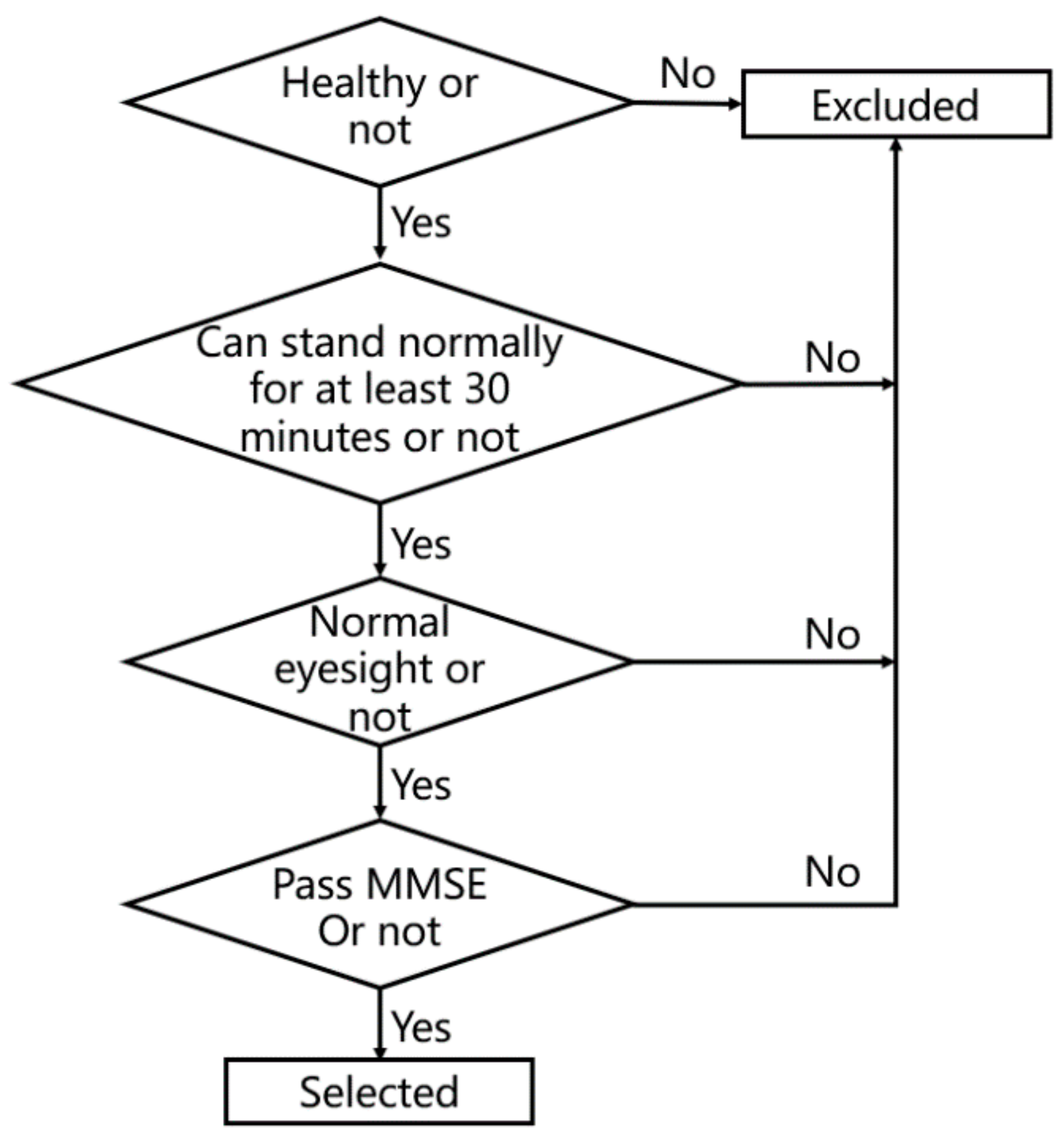
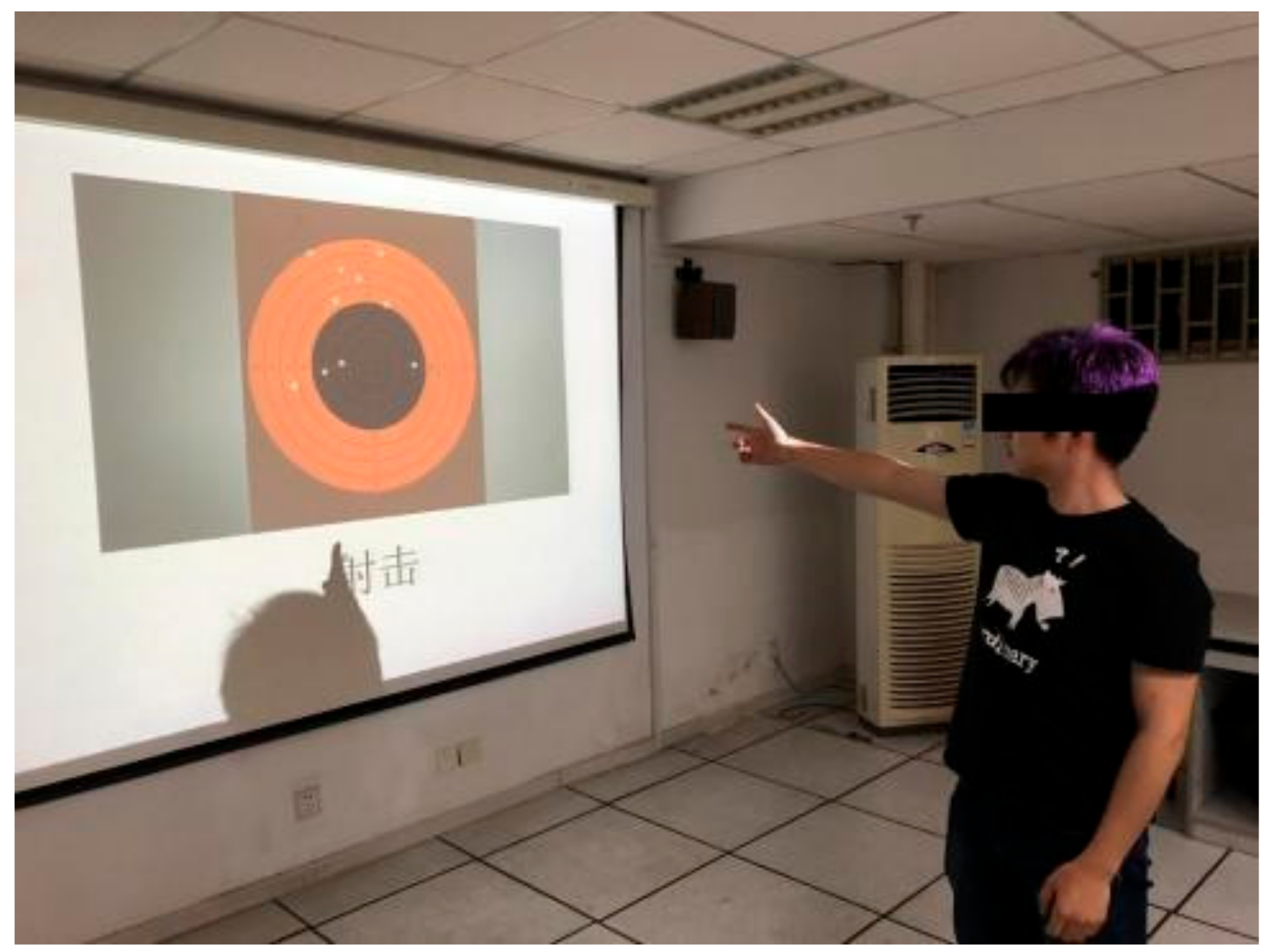
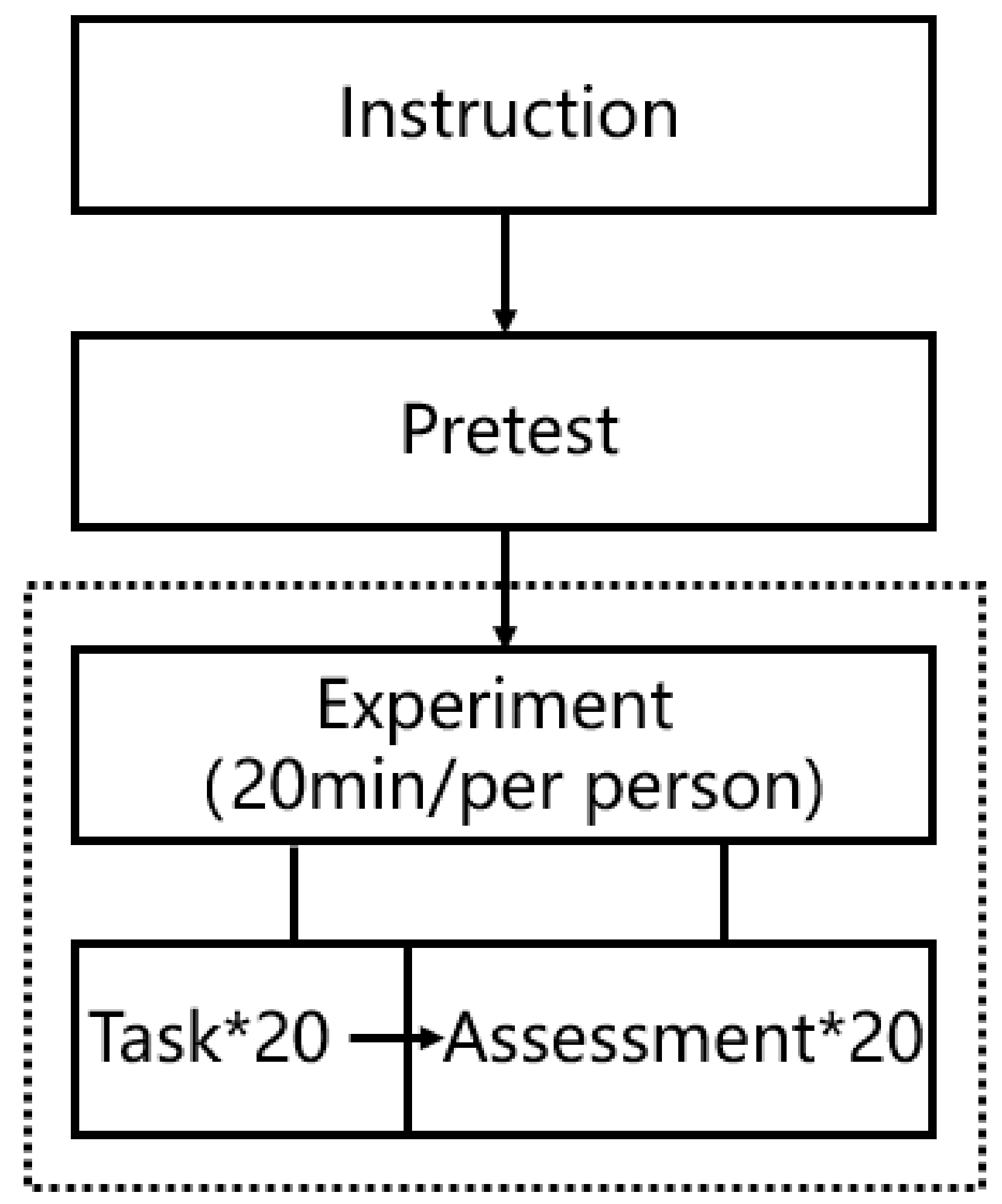
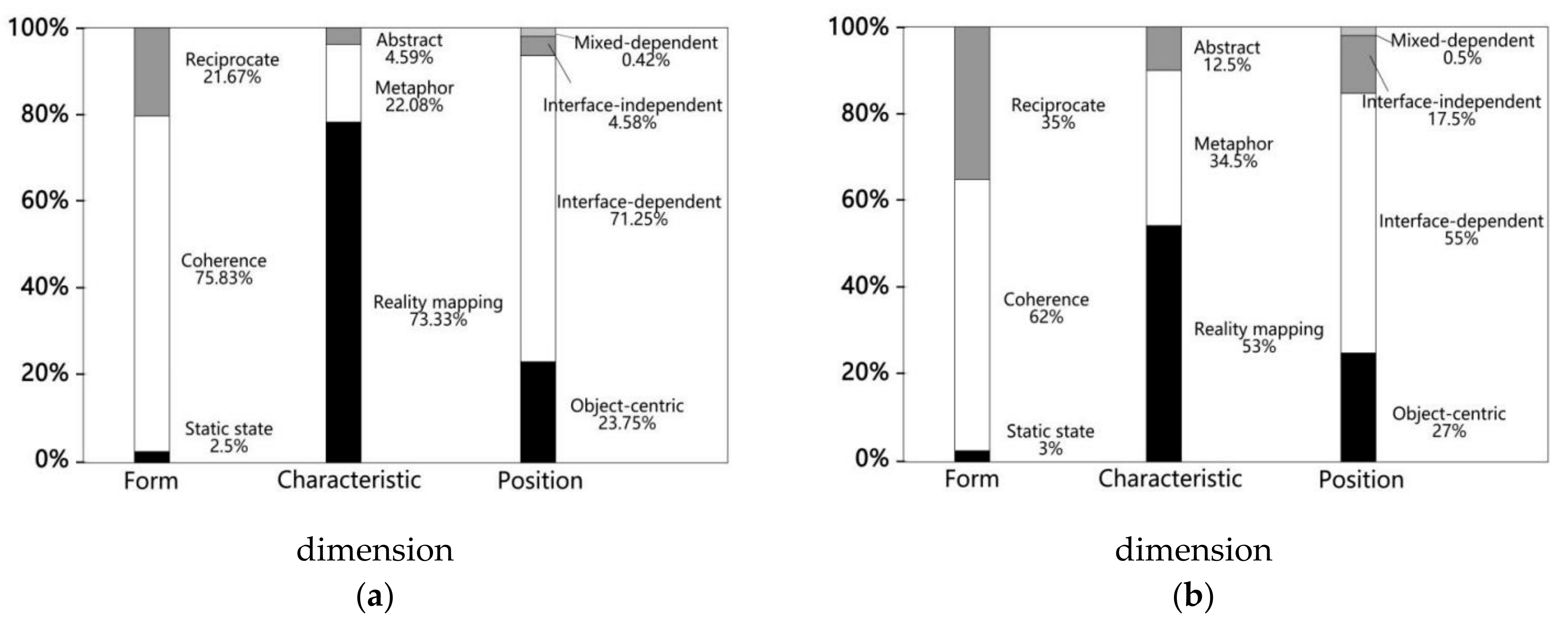

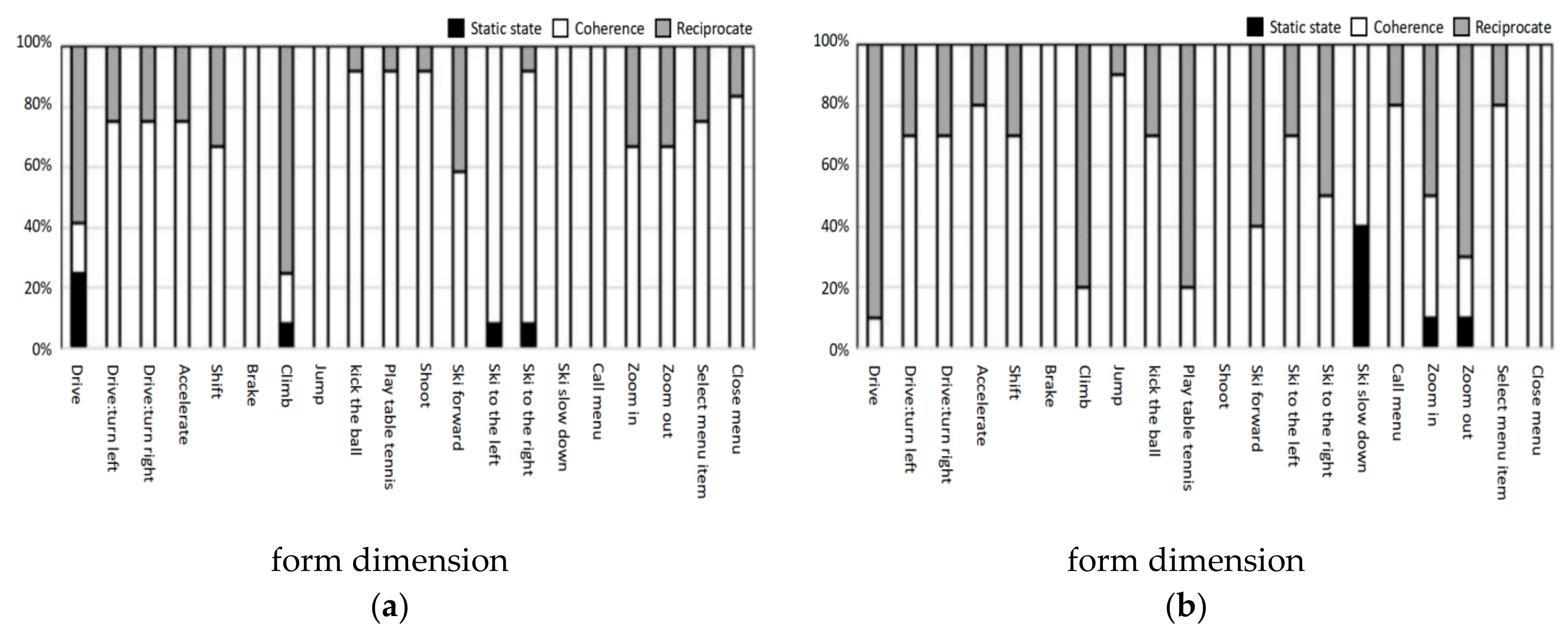
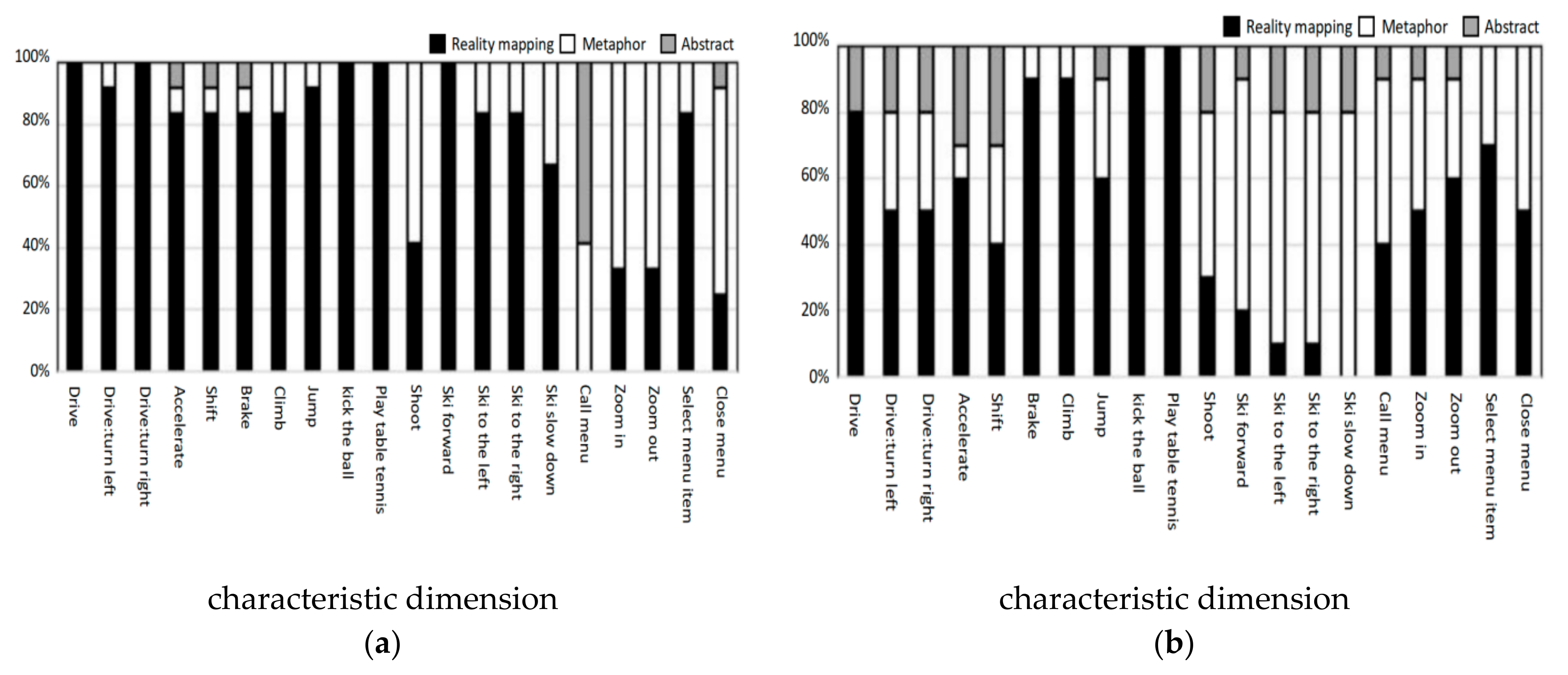

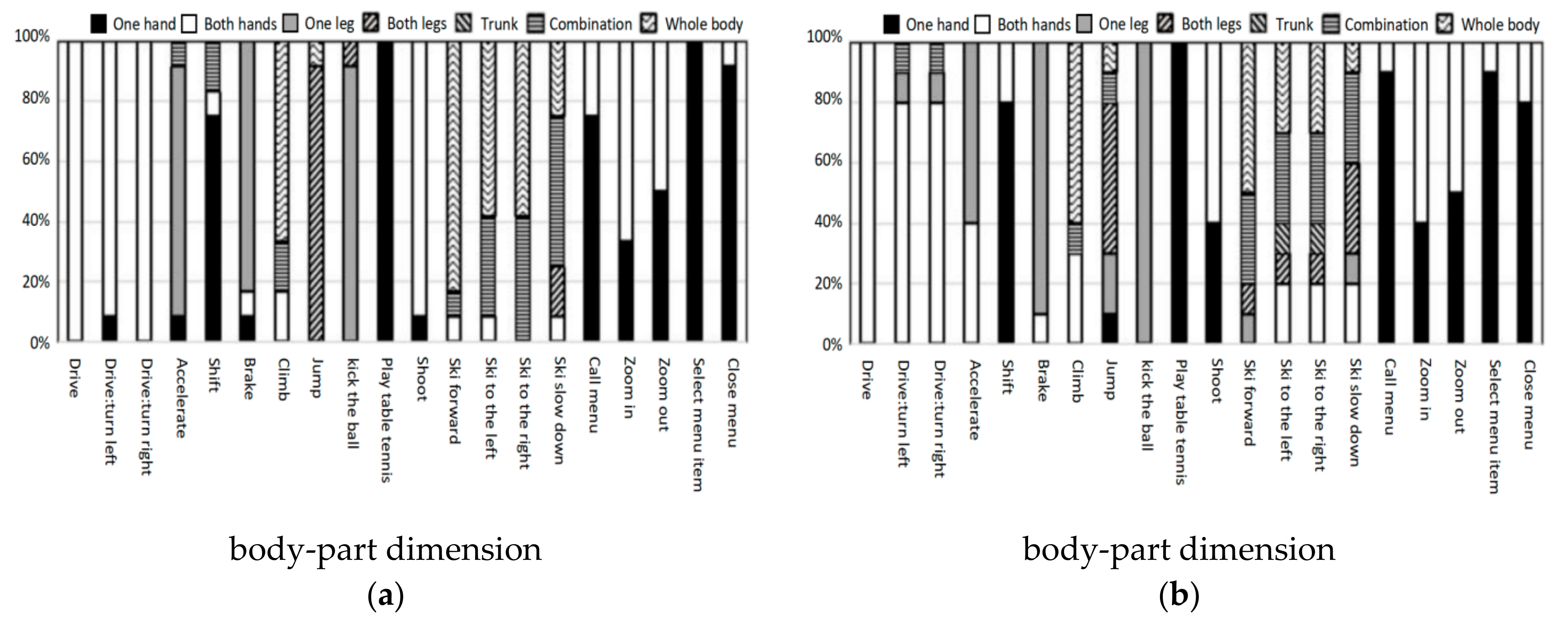
| Characteristic | Young Group | Elderly Group | |
|---|---|---|---|
| Gender | Male | 6 | 2 |
| Female | 6 | 11 | |
| Age | 20–30 | Over 60 | |
| Game experience | More than 15 h a week | 7 | 0 |
| Less than 15 h a week | 5 | 3 | |
| No | 0 | 10 | |
| 3D Game experience (Yes) | 2 | 0 | |
| Driving experience (Yes) | 10 | 0 | |
| Skiing experience (Yes) | 2 | 0 | |
| Category | Task |
|---|---|
| Driving Game | Drive |
| Turn left | |
| Turn right | |
| Accelerate | |
| Shift | |
| Brake | |
| Sports game | Climb |
| Jump | |
| Kick the ball | |
| Play table tennis | |
| Shoot | |
| Ski forward | |
| Ski to the right | |
| Ski to the left | |
| Ski slow down | |
| System command | Call menu |
| Zoom in | |
| Zoom out | |
| Select menu item | |
| Close menu |
| Dimensions | Categories | Descriptions |
|---|---|---|
| Form | Static state | The action is mainly a static posture. |
| Coherence | The action includes a coherent movements of body parts. | |
| Reciprocate | The action includes a multiple reciprocating movements of body parts. | |
| Characteristic | Reality mapping | The action is a mapping of the real world. |
| Metaphor | The action expresses metaphorical. | |
| Abstract | The mapping of the action is arbitrary. | |
| Position | Object-centric | The position is defined for object features. |
| Interface-dependent | The position is defined for the environmental features displayed on the interface. | |
| Interface-independent | The position ignores the environmental features displayed by the interface. | |
| Mixed-dependent | The position is defined not only for environmental features displayed on the interface but also for object or non-environmental features. | |
| Body part | One hand | The action is mainly performed by one hand. |
| Both hands | The action is mainly performed by both hand. | |
| One leg | The action is mainly performed by one leg. | |
| Both legs | The action is mainly performed by both leg. | |
| Trunk | The action is mainly performed by trunk. | |
| Combination | The action mainly involves two or more body parts but does not produce whole-body movement. | |
| Whole body | The action involves whole-body movement. |
| Dimension | Classification | Adjusted Residuals (Young Group) | Sig. (Bilateral) | Cramer’s V Value |
|---|---|---|---|---|
| Form | Static state | −0.3 | 0.006 ** | 0.151 |
| Coherence | 3.1 | |||
| Reciprocate | −0.1 | |||
| Characteristic | Reality mapping | 4.4 | 0.000 ** | 0.221 |
| Metaphorical | −2.9 | |||
| Abstract | −3.0 | |||
| Position | Object-centric | −0.8 | 0.000 ** | 0.226 |
| Interface-dependent | 3.5 | |||
| Interface-independent | −4.4 | |||
| Mixed-dependent | −0.1 | |||
| Body Part | One hand | −0.3 | 0.483 | — |
| Both hands | −0.4 | |||
| One leg | −0.8 | |||
| Both legs | 0.2 | |||
| Trunk | −1.6 | |||
| Combination | 0.3 | |||
| Whole body | 1.7 |
Publisher’s Note: MDPI stays neutral with regard to jurisdictional claims in published maps and institutional affiliations. |
© 2021 by the authors. Licensee MDPI, Basel, Switzerland. This article is an open access article distributed under the terms and conditions of the Creative Commons Attribution (CC BY) license (https://creativecommons.org/licenses/by/4.0/).
Share and Cite
Wang, Y.; Huang, Y.; Xu, J.; Bao, D. Interaction Preference Differences between Elderly and Younger Exergame Users. Int. J. Environ. Res. Public Health 2021, 18, 12583. https://doi.org/10.3390/ijerph182312583
Wang Y, Huang Y, Xu J, Bao D. Interaction Preference Differences between Elderly and Younger Exergame Users. International Journal of Environmental Research and Public Health. 2021; 18(23):12583. https://doi.org/10.3390/ijerph182312583
Chicago/Turabian StyleWang, Ying, Yuanyuan Huang, Junjie Xu, and Defu Bao. 2021. "Interaction Preference Differences between Elderly and Younger Exergame Users" International Journal of Environmental Research and Public Health 18, no. 23: 12583. https://doi.org/10.3390/ijerph182312583
APA StyleWang, Y., Huang, Y., Xu, J., & Bao, D. (2021). Interaction Preference Differences between Elderly and Younger Exergame Users. International Journal of Environmental Research and Public Health, 18(23), 12583. https://doi.org/10.3390/ijerph182312583






